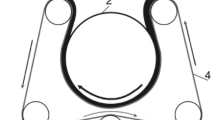Abstract
In this study, the tensile strength and elongation of polyester/viscose blended needle-punched nonwovens were analyzed. For this purpose, five different blend ratios of polyester/viscose webs were produced, cross-lapped and needled in four different mass per unit areas and three different needling/punching densities. The tensile properties of the nonwovens were determined by performing the standard test methods and the data obtained from tests were statistically analyzed in Design Expert software. In addition, a mixture process crossed regression model with two mixture components (polyester and viscose blend ratios) and two process variables (fabric mass per unit area and needling density) was developed to analyze the tensile strength and elongation of polyester/viscose blended needled nonwovens. In conclusion, the regression model indicated that the tensile strength of the needle-punched nonwovens decreases with the increase of polyester proportion in the mixture and increases with the increase in mass per unit area and punching density.
Similar content being viewed by others
References
S. Backer and D. R. Petterson, Text. Res. J., 30, 704 (1960).
S. Adanur and T. Liao, Text. Res. J., 69, 816 (1999).
A. Rawal, J. Ind. Text., 36, 133 (2006).
L. Gardmark and L. Martensson, Text. Res. J., 36, 1037 (1966).
J. W. S. Hearle and M. A. I. Sultan, J. Text. Inst., 58, 251 (1967).
J. W. S. Hearle, M. A. I. Sultan, and T. N. Choudhari, J. Text. Inst., 59, 103 (1968).
J. W. S. Hearle and M. A. I. Sultan, J. Text. Inst., 59, 183 (1968).
A. Watanable, M. Miwa, A. Takeno, and T. Yokoi, Text. Res. J., 65, 213 (1995).
A. Watanable, M. Miwa, T. Yokoi, and A. Nakayama, Text. Res. J., 68, 77 (1998).
A. Watanable, M. Miwa, T. Yokoi, and A. Nakayama, Text. Res. J., 68, 171 (1998).
S. H. Lee and T. J. Kan, J. Compos. Mater., 34, 816 (2000).
S. Ghosh and L. Chapman, J. Text. Inst., 93, 75 (2002).
S. Sengupta and A. N. Roy, The Institution of Engineers (India)-TX, 86, 16 (2005).
S. Sengupta, P. K. Majumdar, and P. Ray, The Institution of Engineers (India)-TX, 89, 16 (2008).
V. K. Kothari, A. Das, and A. Sarkar, Ind. J. Fibre Text. Res., 32, 196 (2007).
R. D. Anandjiwala and L. Boguslavsky, Text. Res. J., 78, 614 (2008).
R. Bulacu, M. Zamfir, G. Loghin, G. Dobre, and M. Ciocoiu, Buletinul Institutului Politechnic Din Ia i, LVI, 51 (2010).
G. Dogan, M. Tercan, and M. E. Yuksekkaya, J. Text. Eng., 75–76, 11 (2010). (In Turkish)
A. Rawal, A. Majumdar, S. Anand, and T. Shah, J. Appl. Polym. Sci., 112, 3575 (2009).
S. Debnath, “Modelling of Needle-Punched Nonwoven Fabric Properties Using Artificial Neural Network”, pp.65–88, Artificial Neural Networks-Industrial and Control Engineering Applications, In Tech, 2011.
S. J. Russell, “Handbook of Nonwovens”, Woodhead Publishing Limited and CRC Press, pp.223–255, England, 2007.
D. C. Montgomery, “Design and Analysis of Experiments”, pp.472–484, John Wiley & Sons Inc., USA, 2001.
Author information
Authors and Affiliations
Corresponding author
Rights and permissions
About this article
Cite this article
Çinçik, E., Koç, E. The effect of blend ratio and process parameters on tensile properties of polyester/viscose blended needle-punched nonwovens. Fibers Polym 14, 1040–1049 (2013). https://doi.org/10.1007/s12221-013-1040-4
Received:
Accepted:
Published:
Issue Date:
DOI: https://doi.org/10.1007/s12221-013-1040-4




